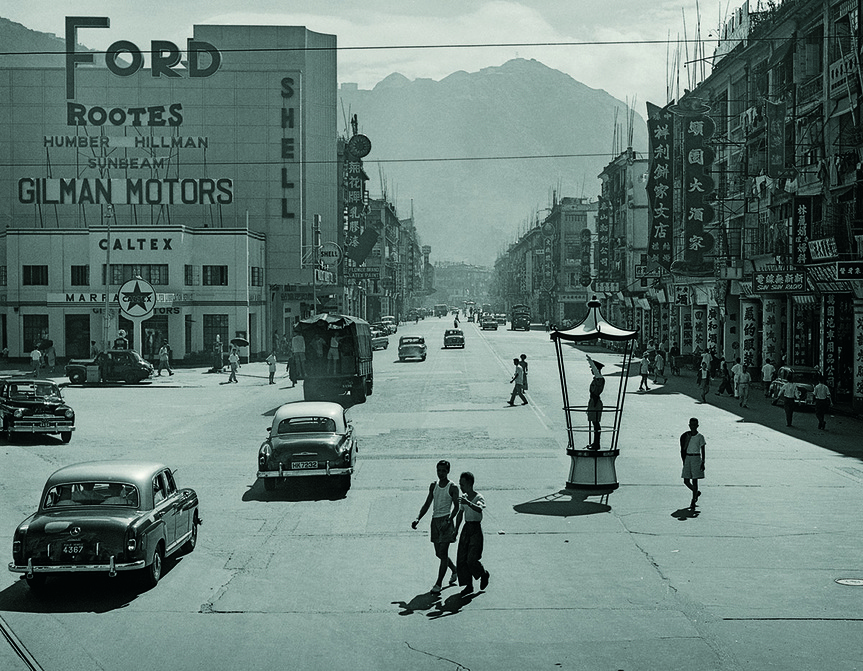
R
E
V N
E
X
T
Hong Kong has a special relationship to time. There is almost no other political jurisdiction in the world with an active countdown to its own ending—which, in the city’s case, is July 1, 2047, when the “One Country, Two Systems” policy, granting the former British colony a “high degree of autonomy” under Chinese rule, expires. This condition colors the lives of residents with a strange anxiety. We experience an identity crisis not just in the present tense, but also the past and the future: who were we, who are we now, and what will we become?
Photographs also exist in multiple tenses. Their meanings change depending on when they are viewed. As Roland Barthes pointed out, all photographs become surreal and intensely moving objects after a while, thus representing the passing of time itself. Old photographs are like distant beacons on a receding horizon, reminding us how far out we are at sea. This is evident with the work of Hong Kong artist Ho Fan. After being largely overlooked for decades, the recent reappearance of Ho’s photographs marks the city’s sudden remembering, at a crucial moment, of long-forgotten dreams.
As the last project he worked on before he died last year at the age of 84, Portrait of Hong Kong may be Ho Fan’s most intimate and masterful monograph yet. The artist, his family and Blue Lotus Gallery founder and director Sarah Greene labored on its production up until the final moments of his battle with pneumonia; he was reportedly discussing cover designs on his last day. The attention to detail is evident. Steering away from the crowd-pleasing visual puns and dazzling geometric exercises that have become the photographer’s hallmark, Portrait contains introductory notes by film director John Woo and an essay by Professor Joseph Fung to accompany a generous and thoughtfully sequenced selection of previously unpublished images from the 1950s and 1960s, revealing a more humanistic portrayal of city life. Some of these were on display at Sotheby’s Hong Kong in June, for “Visual Dialogues: Hong Kong through the Lens of Fan Ho,” an exhibition which opened in conjunction with the book’s publication.
Ho Fan’s work is often praised as a valuable record of old Hong Kong—but there already exist comprehensive archival collections that provide more objective, deadpan descriptions of Hong Kong’s geography. The true value of Ho’s photographs is not expository but poetic. He conveys the knowledge of a lover, obsessively returning to certain picturesque corridors or seasides like leitmotifs, the way one might trace a partner’s neck or ear. His work is an invitation to romance; to set the tone, Sotheby’s Hong Kong filled the exhibition space with softly playing 1960s American and Cantopop songs.
What stands out in the book is Ho’s dedication to the image of working class Hong Kongers. Labor is depicted with dignity—though Ho belonged to a privileged family, his photographic gestures reveal a thorough sensitivity to the rhythm of Hong Kong’s most proletarian streets. But the true stars of Ho’s pictures are the city’s working children: the artist casts them as dreamers, heroes. The artist points to the barefooted kids’ wide-eyed reverie amid hardship. Perhaps it is upon this hopeful core that one of the world’s most stunning metropolises was built.
Ho’s work allows us to imagine a simplified idea of Hong Kong. His images are sites upon which old stories are confirmed or new memories constructed about the character of our society. Anyone with knowledge of the “good old days” will find solace in these photos. However, the meaning we unearth in them reflects contemporary concerns. Italo Calvino said: “With cities, it is as with dreams: everything imaginable can be dreamed, but even the most unexpected dream is a rebus that conceals a desire, or its reverse, a fear.” In the same way, dreaming about the images of Hong Kong’s past is just one way of approaching (or perhaps avoiding) anxieties in the present.
I wondered: would a photographer be compelled to create work like Ho Fan’s today? Whereas postwar Hong Kong largely promised social mobility, today its inequality has reached record levels. Facing an entrenched oligarchy and stagnant wages, even highly educated young people risk permanent exclusion from the middle class. Meanwhile, elderly relatives dig with crooked backs through trash to earn recycling money. Ho’s iconic picture of a young boy prancing across a Hong Kong thoroughfare—the lanes undisturbed, curving gracefully under the sun—is a foil to the image of Hong Kong’s streets in 2014, which were choked with desperate student protesters, furious over the collapse of the city’s democratic promises.
For young people, the silver surfaces of Ho Fan’s photographs might function as mirrors for our present selves. Paging through the book days before the 20th anniversary of Hong Kong’s transfer of sovereignty from British to Chinese rule—an occasion for serious reflection about the city’s prospects—I imagined the photographer gave us this final gift to remind us of our resilience. Toward the end, the pictures turn away from streets to the surrounding seas. These circumscribing waters are both part of Hong Kong’s founding story and symbols of its separation and precarity—something we feel each summer when the typhoons arrive, rain lashing, waves thundering ashore. Ho Fan loved to silhouette small figures aboard rugged vessels against these churning marine backdrops. In these images I discover my Hong Kong: adrift, rowing doggedly, against forces far greater than itself.
“Visual Dialogues: Hong Kong through the Lens of Fan Ho” is on view at Sotheby’s Hong Kong until June 30, 2017.
Published by We Press, Portrait of Hong Kong can be purchased through Blue Lotus Gallery.









